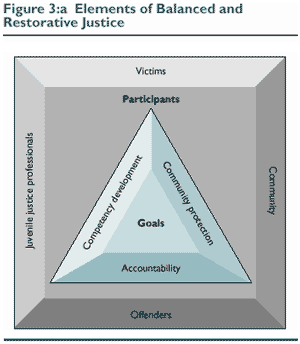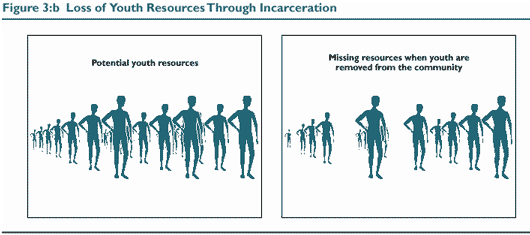Chapter 3: Balanced and Restorative Juvenile Corrections
Balanced and Restorative Justice
Balanced and Restorative Justice is a conceptual framework, based on specific values and principles, that defines this mission of juvenile justice and guides the activities employed to translate these values and this mission into practice. Restorative justice provides an alternative to the punishment and offender rehabilitation approaches to delinquency, although it does not eliminate the appropriate use of confinement and treatment. Rather than punishment and treatment being the first response, however, these activities are among many that may be used in Balanced and Restorative Justice.
Values and Principles
Pranis (1998a) lists 11 key principles of the Balanced and Restorative Justice philosophy (Table 3:b) and provides a restorative justice vision statement in the Guide for Implementing the Balanced and Restorative Justice Model (Table 3:c).
Table 3:b Principles of Balanced and Restorative Justice
Source: Pranis, K., 1998a:5.
|
|
Table 3:c Restorative Justice Vision
Support from the community, opportunity to define the harm experienced, and participation in decisionmaking about steps for repair result in increased victim recovery from the trauma of crime. Community involvement in preventing and controlling juvenile crime, improving neighborhoods, and strengthening the bonds among community members result in community protection. Through understanding the human impact of their behavior, accepting responsibility, expressing remorse, taking action to repair the damage, and developing their own capacities, juvenile offenders become fully integrated, respected members of the community. Juvenile justice professionals act as community justice facilitators, organizing and supporting processes in which individual crime victims, other community members, and juvenile offenders are involved in finding constructive resolutions to delinquency. Source: Pranis, K., 1998a:6.
|
Mission and Goals
To achieve effective juvenile justice, the values, vision, mission, and goals of programs must be consistent. A mission statement should describe the role or function of an agency or program and affirm its underlying values. It should also identify the agency's or program's clients, set goals and performance objectives, prioritize practices and programs, and set forth the roles of staff, youth, and the community. Mission statements provide guidance for allocating resources and are the basis for strategic planning (Bazemore and Washington, 1995).
In juvenile justice, an imaginary pendulum has swung between punitive and rehabilitative missions, but neither approach has alleviated the problem of juvenile crime. Thus, a balanced mission that contains important elements from several perspectives is proposed. The balanced approach mission, first articulated by Maloney, Romig, and Armstrong (1988), has become widely regarded as an effective statement on the purpose of juvenile justice intervention.
As depicted in Figure 3:a, there are three primary goals of the balanced approach: accountability, competency development, and community protection. There also are four types of "players" in this model of juvenile justice: victims, offenders, the community, and juvenile justice professionals.

The three goals are equally important in determining appropriate responses to delinquent offenses and allocating resources. However, this approach allows for youth to be individually assessed and for differing goals to be emphasized depending on a given situation.
Accountability
"Accountability refers specifically to the requirement that offenders make amends for their crimes by repaying or restoring losses to victims and the community" (Bazemore and Washington, 1995:56). There are two important components to the accountability goal: (1) take responsibility for one's behavior, and (2) take action to repair harm. To be accountable is to answer to those affected by one's behavior (Pranis, 1998a). Pranis (1998a:10) lists five requirements for taking full responsibility for behavior:
- Understand how the behavior affected others.
- Acknowledge that behavior was a choice that could have been made differently.
- Acknowledge to those affected that the behavior was harmful to others.
- Take action to repair the harm, where possible.
- Make necessary changes to avoid such behavior in the future.
By taking such responsibility, offenders experience personal growth. However, it is vital that they have a support system to uphold them during this difficult task and help them regain acceptance by the community.
Accountability should not be confused with punishment and restrictions. Rather, it should focus on repairing harm. Having victim and community involvement in the accountability process makes it concrete rather than symbolic, and this is very important because of the level of cognitive development of most youth. Teenagers usually are not yet able to grasp complex abstract ideas, so actually seeing their victim and hearing about specific harm they caused that person is much more effective than more nebulous concepts of "offending against the State" and "paying a debt to society."
Competency Development
Competency development implies that youth should exit the juvenile justice system better able to become productive and responsible members of the community than when they entered the juvenile justice system (Bazemore and Washington, 1995). Stated another way, "competency is the capacity to do something well that others value" (Pranis, 1998a:24). Juvenile offenders need opportunities to perform meaningful tasks in the community and contribute to others' well-being in order to (Pranis, 1998a):
- Belong.
- Contribute.
- Form close relationships.
- Make meaningful choices.
- Develop transferable skills.
- Mentor others.
Areas in which youth may develop competencies include (Pranis, 1998a):
- Vocational skills and values.
- Education, knowledge, reasoning, and creativity.
- Personal and social skills, conflict management, and communication skills.
- Decisionmaking, reasoning, and problem solving.
- Citizenship.
- Health and recreation.
An emerging approach that is useful for competency development is a strengths-based practice that emphasizes building on youths' and families' strengths and positive qualities rather than approaching them from a deficit or pathology frame of reference. Saleeby (1996:298) provides a comparison of the strengths and pathologies perspectives, which is summarized in Table 3:d.
|
Table 3:d Comparison of Strengths and Pathologies Perspectives
Strengths Person is unique, with talents and resources. Intervention is possibility focused. The other/helper (e.g., counselor, juvenile justice practitioner) knows and appreciates the person through personal narratives. Childhood trauma may contribute to strengths or weaknesses of the individual. Youths’, families’, and communities’ aspirations are the focus of the work to be done. Individuals, families, and communities are viewed as experts. Choice, control, commitment, and personal development are possibilities. Strengths, capacities, and adaptive skills are resources for the work to be accomplished. Help focuses on progress—getting on with one’s life, affirming and developing values and commitments, and making and finding memberships in, or as, a community. Pathologies Person is a “case” or diagnosis. Intervention is problem focused. The expert interprets the personal account to arrive at a diagnosis. Childhood trauma predicts later pathology. The practitioner develops a treatment plan for the individual. The professional is the expert concerning clients’ lives. Choice, control, commitment, and personal development are limited by pathology. Knowledge and skills of the professional are the resources for the work to be accomplished. Help involves reducing symptoms and consequences of problems. Source: Saleeby, D., 1996:298.
|
Community Protection
Community protection "explicitly endorses a long time public expectation that juvenile justice must place equal emphasis on promoting public safety and security at the lowest possible cost" (Bazemore and Washington, 1995:56). Practices that reduce risk and promote the capacity of the community to manage behavior should lead to community members living in peace and harmony with mutual respect and citizens feeling as though they can prevent and control crime (Pranis, 1998a).
In a Balanced and Restorative Justice framework, it is believed that youth who have strong connections to their communities and care about people in their neighborhood are less likely to offend. Therefore, it is important that youth remain in the community, when possible, and that practices be implemented to foster positive relationships between young people and their peers, families, and neighbors. There are several ways that delinquent youth can be supervised effectively and still remain in their communities (Pranis, 1998a):
- Supervise and monitor school attendance, employment, and community work service.
- Use day reporting centers.
- Use electronic monitoring.
- Use house arrest.
- Conduct random urinalysis tests.
If it is not possible to reasonably ensure public safety while a youth remains in the community, then residential placement or confinement in a secure facility may be considered as a last resort. However, removing youth from their communities severs prosocial bonds with family and community members and assembles groups of youth who may reinforce primarily antisocial values with each other. In addition, this is the most expensive response to juvenile crime, and it usually precludes the youth from repaying or restoring the victim (Pranis, 1998a). In a Balanced and Restorative Justice framework, the appropriate use of residential placement or secure confinement is to protect the public, not to punish the youth.
Participants
The participants included in a balanced approach also are important to note. Unlike typical responses to justice that overlook the victim and community, this perspective includes them with the offender and juvenile justice personnel as active participants in the process (as shown in Figure 3:a). Using a balanced approach, victims, offenders, and the community should be actively involved and receive fair and balanced attention. The role of the juvenile justice system personnel may be quite different in a program based on the balanced approach than it is in traditional programs.
When and Where Balanced and Restorative Justice Is Implemented
The focus of victim and community involvement in Balanced and Restorative Justice practices centers attention on the area of community corrections for implementation. Probation and aftercare programs certainly are in an ideal position to set such programs in motion. However, it is feasible to integrate these values and goals in residential placements and secure confinement facilities as well. A restorative justice climate can be nurtured through the selection of values, principles, mission, goals, and practices that treat the institution as a community, although a closed one, and foster care, concern, and fairness among residents. When problems arise among youth within a juvenile corrections facility, they can learn restorative justice principles by repairing the harm and restoring their victims within the facility rather than receiving consequences or punishment that are unrelated to their offenses merely for the purpose of retribution. The entire group can practice healthy community roles and learn to support each other when they participate as both victims and offenders. In placement, youth can be given opportunities to perform valuable work and pay restitution for the losses and harm they caused victims in the community. Competency development goals can be pursued through direct teaching and processing experiential opportunities to help youth learn social, academic, problem-solving, vocational, and other valued skills. Ideally, the principles and practices of restorative justice will be woven throughout a jurisdiction's juvenile justice system, and youth, their families, victims, and community members will see it operationalized and modeled by all juvenile justice programs and professionals.
Rose and Clear (1996) argue persuasively that overreliance on incarceration hinders the ability of communities to develop ways of managing members' behavior to control and prevent crime. Youth are viewed as resources in the community even though they may, at times, cause harm or create fear. Removing them weakens the family and community and may deprive the community of present or future contributions from the youth. Losing youth from a community is somewhat like having a tear or imperfection in woven fabric. More stress is placed on the remaining members, and the whole community is weakened and depleted of some of its resources. This is graphically depicted by the comparison shown in Figure 3:b.

From this brief discussion of Balanced and Restorative Justice, its relationship with the general principles of OJJDP's Comprehensive Strategy for Serious, Violent, and Chronic Juvenile Offenders is apparent. Both stress the important role of the family and community in helping individual and collective youth. They also jointly emphasize the significance of placing the majority of efforts on prevention and early intervention, thus minimizing the removal of youth from the community. Table 3:e summarizes the Comprehensive Strategy principles.
Table 3:e General Principles of the Comprehensive Strategy for Serious, Violent, and Chronic Juvenile Offenders
|
| Jurisdictional Technical Assistance Package for Juvenile Corrections | Report - December 2000 |